 |


|
|
|
|
By Randolfe Wicker
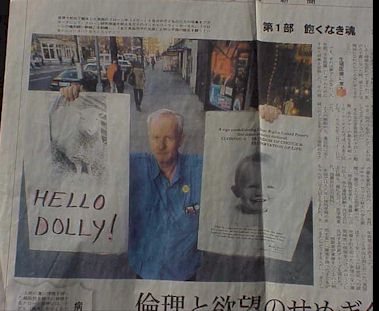 Randolfe Wicker promotes human cloning in a Japanese newspaper. Press coverage of pro-clonging advocates is much more prominent outside of the United States
Randolfe Wicker promotes human cloning in a Japanese newspaper. Press coverage of pro-clonging advocates is much more prominent outside of the United States
This past week, media around the world were filled with glowing reports celebrating five-identical cloned piglets created by a subsidiary of PPL Therapeutics of Edinburgh, Scotland, which nearly four years ago created Dolly, the world's first clone of an adult mammal. PPL's stature and stock value rose on it's assertion that the cloned piglets were a giant stride toward creating genetically engineered pigs whose organs could be transplanted into humans. "PPL said transplantation of genetically altered pig organs could be tested on humans in four years," Yahoo News reported "and analysts believe the market for them could be worth $6 billion for solid organs alone. Other uses include cellular therapies such as transplantable cells that produce insulin for treatment of diabetes." Concurrently, a startling interview by Dr. Alma Bond, a psychologist, with Dr. Ian Wilmut, Dolly's creator at PPL's parent, The Roslin Institute, was published as "a scoop" by the non-profit Georgia-based Human Cloning Foundation and sent to nearly 800 newsletter subscribers and "friends of human cloning" scattered around the world. Roslin Institute's patent on the cloning process developed by Dr. Ian Wilmut has become an important part of a multi-billion bio-tech "gold rush" propelling Nasdaq's spectacular growth and the stock market boom in recent years. Wilmut's success in cloning Dolly startled the scientific community in general for two reasons. To begin with, the brightest, most-highly-regarded experts had concluded years earlier that cloning a mammal was scientifically "impossible". Additionally, this stunning achievement was the work of an unknown animal embryologist in a field viewed condescendingly by some as "barnyard research." "So, it fell to a researcher in the barnyard to accomplish that which all those esteemed professionals had declared from their fancy labs and ivory towers to be 'impossible'" an early report in Gay Today's "Cloning Series" exalted.
It was not until 18 months later, in November 1998, that the controversial patent on cloning technology was transformed, virtually overnight, from a lightning rod of moral controversy into one of the scientific world's strongest magnets for cold hard cash. "Scientists Cultivate Cells at Root of Human Life" The New York Times headlined, November 6,l998, announcing a new breakthrough by a firm named Geron Corporation. Subsequent stories revealed that human stem cells, created from embryos discarded from fertility clinics were not only capable of becoming any of the 210 different cell types found in the human body, but also continued dividing after being cultured in a dish without signs of aging, achieving an apparent "immortality". Suddenly the world was turned upside down. Every researcher in the country now wanted to do "stem cell research." President Clinton, his National Presidential Advisory Board (NBAC), Congressmen and Senators as well, this time were all caught with their pants down. The Republican majority had "thrown a bone" (perhaps you could call it "moral pork") to the Right-to-Life wing of their party by passing legislation "banning Federal funding of fetal tissue research." A "now-you-see-me, now-you-don't" Washington musical dance (reminiscent of that famous political parody using the same language in the film starring Dolly Parton entitled "The Best Little Whorehouse in Texas") commenced. The Democratically controlled National Institutes of Health, realizing the importance of the stem cell breakthrough, ruled that researchers "could work with already existing stem cell cultures." The fetal tissue ban simply prohibited "creating stem cell cultures." The Right-To-Life Republican Congressmen were furious that Democratic Federal bureaucrats were skirting their ban. From their viewpoint, chopping up an embryo before it exceeded eighteen cells to create a "stem cell culture" was nothing less than "taking a human life". That these very embryos were extra, leftovers due to be discarded anyway, didn't matter.
On January 20,1999, a BBC News Headline story entitled: '"Dolly scientist backs human cloning" announced that "Dr. Wilmut is negotiating with the Geron Corporation, a US company funding embryo cloning for medical purposes" "On Newsnight, Dr. Wilmut, from the Roslin Institute in Edinburgh," the BBC reported "was asked whether he felt comfortable about creating a human embryo clone. "He replied 'Yes, I do. I clearly understand that to some people it's deeply offensive and I think it's very important that it is a social decision that's taken…but, yes, I personally would be prepared to do that because these are frightening diseases.'" The BBC reported Geron's team of researchers "expected to begin an embryo project within weeks". Behind those corporate/political/public facades the tempo of the "now-we're-for-it, now-we're-not" political maneuvering apparently became overwhelming. By June 15,l999, just six months later, a New York Times story by Nicholas Wade (pg. A21) blared: "No Research On Cloning Of Embryos, Geron Says". Now, Geron Corporation said it was "only conducting research on discarded human embryos". Geron denied, "it was trying to create cloned human embryos and said that it had no intention of doing so." Geron was to" concentrate on working with animal eggs and with human eggs rejected by fertility clinics because they were not viable." Geron Corporation, whose researchers isolated stem cells were now working with a license from Roslin Institute. Ian Wilmut was not to be heard from. Both Wilmut and Geron Corporation had always emphasized that the human embryos they created through cloning would be chopped up to create stem cell cultures. Under no circumstances would either allow such an embryo to grow, start differentiating, be placed into a woman's womb and develop into a child. "It's fine to clone to kill," attorney Mark Eibert, who advocates allowing infertile couples to use cloning technology to have their own children, commented bitterly. "But it is illegal and immoral to clone to love, nurture and bring a wanted child into the world." Not long ago Alma H. Bond, Ph.D., a psychologist, emailed Dr. Wilmut saying she would like to interview him.
"Dr. Wilmut responded with an invitation to visit him at Roslyn the next week. Although I was delighted to accept, I wondered why this famous man who is bombarded with requests for interviews agreed to see me. I was not to discover why until late in the interview. " Connection to the full text of Dr. Bond's 5 page interview can be accessed later though the following link anyboard.humancloning.org/anyboard/forum1/posts/116.html Concisely put, Dr. Bond's description of the impressive country road, and a prefabricated building, 60's style, which "could easily serve as the headquarters of a light bulb manufacturer in the United States" was exactly the physical environment one might expect to surround an animal embryologist, concededly referred to as "a barnyard researcher." Wilmut talked easily about his doubts revolving around "normal relationships" in a family with a cloned person it it. He reminisced about similarities with and questions he would like to ask his own father who had died three years earlier. He explained the difficulties, deformities and unexplained deaths shortly after brith of his own cloned sheep, dismissed cloning as a "cure" for infertility. His arguments were familiar ones but reasonably and civilly explained. Then Wilmut commenced outdoing himself "you need an egg and sperm from a donor to produce a clone." he declared, apparently oblivious to his own feat of creating Dolly using three females – one a cell donor, the second an egg donor and the third the birth mother. No males had been involved. Hadn't this man realized he had brought about same sex reproduction in mammals for the first time in history? "Doesn't Wilmut even know what is being said in the public debates about cloning," I ask myself, "the technology he pushed to the forefront of science". I recall a story from my high school days. Two children find one of the world's largest diamonds (not the "hope" diamond) lying by an African road. Without realizing the value of their discovery, they sell it to a tourist for a dollar. Momentarily, this crosses my mind as an exaggerated metaphor for Wilmut's seemingly sad lack of awareness. Indeed, in the days following the announcement of the birth of Dolly when I had first commenced the "Pro Human Cloning Campaign" which has consumed my life ever since, I'd mistakenly jumped to the erroneous conclusion that much of the virulent opposition to cloning human beings was based on a basically homophobic reaction to same sex mammalian reproduction. I'd held the first demonstration within the week at the site of New York City's Gay Monument opposite the Stonewall Bar in Sheridan Square, choosing to carry a placard proclaiming: 'ANTI-CLONING ZEALOTRY = HOMOPHOBIA' This was a choice and a strategy I would later come to regret. The emotions swirling around human cloning were infinitely more complex. As the movement grew, I grew in my understanding of many issues I'd never understood before. Millions of heterosexuals had closets of their own. It was called "infertility". Through all this I found the gay culture took widely different positions regarding human cloning. Some angry veterans of Stonewall had tried to have me kicked out of their contingent in the 1998 Gay Pride Parade for carrying a sign that proclaimed "Cloning Same-Sex Reproduction = Gay Rights".
 Randolfe Wicker (left) holds the pro-cloning rights sign that almost got him kicked out of the 1998 New York City Gay Pride Parade
Randolfe Wicker (left) holds the pro-cloning rights sign that almost got him kicked out of the 1998 New York City Gay Pride Parade
However, many onlookers, especially lesbians, cheered. Several rushed up off the sidewalks and asked if they could march with me. This was reassuring but I had to decline their support since I was marching with a group at the very head of the parade all of whom were 'supposed' to be "Veterans of Stonewall". The Human Rights Campaign Fund has so far dodged the cloning issue. That I could stand, but their endorsement of Al D'Amato was the straw that broke my back. In 1999, I stuffed cloning literature into their "postage prepaid" envelope and told them to let "their pal Al"pay my dues for the rest of the Millennium. But whatever the gay community lacked, I have managed to find elsewhere. I met and came to know single women, heterosexual and homosexual, who'd never met a male they considered "fit" to be the father of their child and yet they desired children. There would be strange moments-the guy who had just put his dead cat in the deep freeze and wanted to know where to go to have it cloned. Most touching would be those encounters with young people struggling with kidney disease, a syndrome as fatal as AIDS used to be. And then there would be the mother seeking to retrieve a lost young son. He had been "the perfect person". anyboard.humancloning.org/postsupport/posts/93.html Heterodoxy, a magazine published by The Institute for the Study of Popular Culture framed the issue is entitling it "Gay Clones" subheading it with a statement I managed to correct before it ran in Playboy Magazine-"Heterosexuality is historically obsolete!" (I'd gotten sloppy with my language. I'd intended to say "Heterosexuality's historic monopoly on reproduction is historically obsolete." My first reading of Ian Wilmut's interview with Alma Bond simply enraged me. I'd fired off an angry letter to "Wired News" denouncing it as "homophobic" and "racist". It had been nearly two years since my first reading of "Remaking Eden" during a trip to Washington where I was to testify before a Congressional subcommittee against a proposed Federal law banning cloning. The chimera discussion had impressed me because I had encountered the first such "patchy" person of color (light and darker brown) a few months earlier-something I'd never seen before in sixty years of life.
After listening to Wilmut's long rambling reflection on children conceived though cloning being different from the original, cloning being misrepresented as some sort of shabby key to immortality, etc. Dr. Bond suggested the possibility of "strict rules and restrictions about who is fit to raise a cloned child, such as people have to go though for an adoption?" Ian Wilmut, taken aback, responded, "It is very unusual to have an American talking about regulations. Usually if you can afford to pay for something you've got it." I found myself chuckling at this Englishly amusing Quentin Crispish observation, especially since Wilmut seemed to be revealing himself as an odd mixture of dimwit and discoverer. After insisting "no" scientist anywhere in the would was working on cloning a human being in secret", Dr. Bond pointed to "Lee Silver, the Princeton Professor of Microbiology", whose book Remaking Eden (see review – Cloning Series). "He is not a clinical scientist", Wilmut responds, "but teaches ethics." Anyone knowledgeable in the field has to wince at the arrogance of Wilmut's ignorance. Since "Remaking Eden" first rolled off the presses in 1997, Lee Sliver has come to frame and dominate the public discussion of both human cloning and genetic engineering. He has appeared in several BBC documentaries on cloning. ABC's hour long documentary in the fall of 1999 was totally framed by Slivers ideas on both the positive potential of technology as well as his concerns for problems that may lie ahead. Apparently Ian Wilmut had not read the biographical profile on Dr. Lee Silver's book jacket – "Remaking Eden". The text is as follows:
In a stunning interview in Reason Magazine, May 1999, entitled "Liberating Biology" (available online at www.reason.com and highly recommended by this writer) Sliver notes ,"There is a conflict going on between the faculty in my department and me. My literary agent says I have been 'Saganized' because I am popularizing science," he says, referring to the late planetary scientist and public television star Carl Sagan. "I think (my co-workers) are sort of angry at me for spending time with something that they think is not worth spending time on, which is going out in the world and talking, as opposed to sitting at the bench doing science." One result of his going out in the world, the Reason Interviewer noted, Later this year, Silver will become a half-time professor at Princeton's Woodrow Wilson School of Public and International Affairs. Next this seemingly likeable, though poorly informed animal embryologist exposes near total confusion about Lee Sliver's detailing of the possibilities of same-sex reproductive cloning technology. The following is an excerpt from Dr. Alma H. Bonds interview with Ian Wilmut: "I.W. He is not a clinical scientist, but teaches ethics. Silver's opinion is not based on reality. For example, let's say you have lesbian couples that want to have a child together. They each get inseminated. You mix their embryos and get a chimera. Did you ever see a chimera? If one of the women were blond and the other dark, you would get a person full of patches of different color hair. (He opens a book and holds up a picture of a white mouse that looked as if it were splattered with black paint.) The child would look like this, with strands of dark hair mixed in with the blond. They are not going to be able to hide the patches. If the child were formed by mixing black and Caucasian embryos, you would get a person with patches of black and white skin. Also, the child of that chimera is going to be the child of only one of the women, and the grandchild will be the descendant of only one of them." Compare this with Lee Sliver's first explanation of lesbian co-partnership (page 116) in "Remaking Eden". "Lesbian couples, in particular, would have a new way to share biological parentage of a child. One member of the couple could provide the donor cell, and either one could provide the unfertilized recipient egg. The newly formed embryo could then be introduced into the uterus of the genetically unrelated woman. The child that is born would be related by genes to one mother, and related by birthing to the other, so that both women could rightly call themselves biological parents. Admittedly, Sliver spends eight pages later in Remaking Eden (pages 182-190) giving flesh, names, reality, to another visible of two lesbian women 'Cheryl and Made Lain's Baby' undertaking co-parenting." Sliver described his own personal feeling toward reproduction in Reason Magazine May '99 interview: Reason: In Remaking Eden, you basically come out in favor of human cloning. Would you consider cloning yourself? Silver: I am not interested. I already have children. Obviously, I have been asked this question many times. I felt the need, probably instinctive, to have children with my wife. And I didn't want to have children that were just for me. I wanted to have children that consummated my relationship with my wife to the greatest extent, and that is why I have my children Whether he is making a valid projection or not, Silvers lesbian couple, Cheryl and Madeleine, share the same emotional need as Silver to have children "sharing both of their genes". But Madeleine and Cheryl's process of having chimeric children is carefully controlled. Chimeras are the opposite of twins. In twins, one embryo splits into two. In chimeras, two embryos are combined into one. The male sperm donor is carefully chosen so his skin tone is midway between their own, making "blotchy" offspring impossible. They both want daughters so the sperm is sorted so there is a 90% chance of female embryos. Every fertilized embryo from each woman is tested to insure its sexual identity. Then, one female embryo from each is placed into a tray and induced to fuse. The resulting chimera embryo is then implanted into either woman's womb. The resulting child is 25% genetically related to each of the women and 50% genetically related to the male sperm donor. In " Remaking Eden" both Cheryl and Madeleine end up bearing one daughter. Their daughters are sisters, both the same age, but not twins.
Silver theorizes that since most embryos, which merge in nature, have the same biological parents, few would exhibit any such identifiable traits. Most chimeric children are unaware of their status. There would be no tell tale mixed coloration purposely induced in mice. Indeed, the concept of natural chimeras might be the key to understanding transexualism and transgenderism—an idea Silver does not explore. They might also explain something other researchers like Lawrence Wright, author of a book entitled "TWINS And What They Tell Us About Who We Are, calls "twin mysteries". "With the increasing use of ultrasound to detect early pregnancies," Wright notes (pg. 87)," we now know that winning is a far more common occurrence than anyone had previously imagines. Although only about one out of eighty or ninety live births produces twins, at least one-eight of all natural pregnancies begin as twins. Many of us singletons, in other words, began life as something more---as part of a pair." This phenomenon is known as "the disappearing twin syndrome". Only rarely are their signs of an early miscarriage. Most believe one twin simply absorbs the other. My own encounters with women passionately wanting to bear children through cloning have all been single women, homosexual and heterosexual. One middle-aged lesbian had been caught off guard by an unexpected premature hysterectomy. She thinks of her cloned daughter not just as an extension of herself but also as a continuation of her own mother and grandmother. Another women desperately wanted to bear a daughter who would be her later born twin because she herself was an identical twin and "the relationship I have with my sister is incomparable to any relationship I have ever had with any other human being in my entire life!"
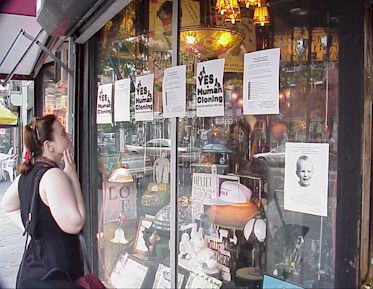 Woman looks at pro-cloning literature on the window of Randolfe Wicker's Art Deco Lighting Shop
Woman looks at pro-cloning literature on the window of Randolfe Wicker's Art Deco Lighting Shop
Infertile heterosexual couples spend fortunes on usually ineffective fertility treatments because they want "their" children's children genetically related to themselves. They don't want a stranger's genes injected into their family tree. I suspect most lesbian couples would choose likewise and forgo chimeric children, 50% of whose genes came from neither of them. I called Dr. Alma Bond while gathering this material suggesting to her that Ian Wilmut's description of lesbian co-partnering reeked of homophobia and racism to me. "No" Dr. Bond assured me, she had not detected inklings of either homophobia or racism in Ian Wilmut. He had simply picked up the book to show her what he obviously knew what chimera mice "looked like". Apparently, the animal embroyologist had projected his limited knowledge onto a misunderstood interpretation of Lee Silver's lesbian parenting sections. Oh well, all of this caused me to re-examine materials gleamed over the past three years.
The disappearance of a news story from the BBC Archives was both baffling and frightening. However, I knew laws regulating the press in The England were quite different from those regulating the press in the United States. Some tabloid had actually been made to pay $50,000 or $100,000 to Liberace at some point during the late 50's or early 60's for printing a story saying he was a homosexual. I'd always been astounded by that fact, even to the point of suspecting that Liberace was either celibate or a big swishy heterosexual. I was sure that with that kind of money at stake some little queen would rush forward to spill the beans. Perhaps the BBC had no choice but the remove Geron's announced plan to clone human embryos after it had backed out of doing so. Human cloning, stem cell research, reproductive rights, scientific freedoms are increasingly interconnected especially in cyberspace and on the Internet. Web searches for cloning pulls up the Gay Today's historic series with other links to biotechnology articles and yet others to gay related materials. I opened the New York Times, Thursday, March 16th, 2000, to see Lee Silver had an Op Ed piece entitled " Who owns the human genome – taking a stand in the middle of this latest technological debate and arguing there's nothing wrong with science for profit" and wondering if Bill Clinton's and Tony Blair's joint declaration might be misguided. "Unfortunately biotechnology isn't like any other business", Silver concluded, "The public is understandably nervous about the idea of companies profiting from our genetic code. Bit if the goal is to make this genetic information useful as soon as possible, the debate should be focused on fair business practices and regulatory issues, not on ethics." The next day, the New York Times headline "Vermont House Backs Wide Rights For Gay Couples" – Vote for 'civil unions – no same-sex marriages but many parallel benefits – Senate approval seen. Finally, fearing I would commence writing the book for which I had not yet found time, I took one more look at the book I'd proclaimed to be "The Book Of The Century" in early 1998 – "Remaking Eden" (page 188) "Some people may think it is wrong for a child to be raised by gay parents. A direct response to this concern is beyond the scope of this book. Suffice it to say that hundreds of thousands of children are being raised by gay parents right now in America, and high courts in several states have acted to legitimize same-sex parenting arrangements. One cannot reject chimera formation solely because of the possibility that it would be used primarily by gay parents. As an aside, it is interesting to note that a major argument used by the Religious Right in its opposition to same-sex unions is based on the notion that marriage is supposed to serve the purpose of procreation. According to this line of reasoning, gay unions should not be sanctioned because they are biologically barren. If we take the Religious Right at its word, the ability of gay women, or gay men, to co-procreate should validate their right to become married." Somehow, finally, all the pieces of the puzzle were falling into their proper place. It really didn't matter if one barnyard researcher and assorted other gay and straight dimwits didn't have enough sense to come in out of the rain. Suggested Further Readings Remaking Eden, Cloning And Beyond In A Brace New World – Lee M. Silver, Avon Books, New York, 1997 The Clone Age – Lori B. Andrews, Henry Holt & Company, Inc., New York, 1999 Great resource for the history of the American fertility industry — and many unrelated issues therein; the author unfortunately at this time opposes the cloning of humans. Twins, And What They Tell Us About Who We Are – Lawrence Wright, John Wiley & Sons, Inc., New York, 1998 Controlling Human Heredity, 1865 To The Present – Diane B. Paul, Humanity Books, an imprint of Prometheus Books, New York, 1998 A fantastically valuable study of genetic issues from Darwin's time to just before the arrival of cloning. Who's Afraid Of Human Cloning – Gregory E. Pence, Rowman & Littlefield Publishers, Inc., New York, 1998 Reason Magazine Articles, www.reason.com Petri Dish Politics -- December 1999 Warning: Bioethics May Be Hazardous to Your Health -- August/September 1999 Liberation Biology -- May 1999 Send in the Clones -- June 1998, |

© 1997-2000 BEI
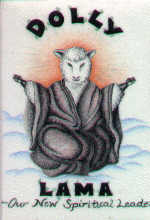 Clone Rights United Front issued
this humorous button tribute to Dolly
immediately following her birth.
Clone Rights United Front issued
this humorous button tribute to Dolly
immediately following her birth. Dr. Alma Bond
Dr. Alma Bond 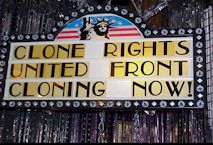
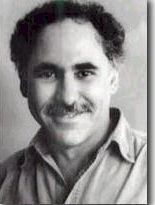 Lee Silver
Lee Silver 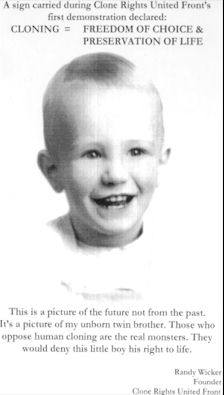 A leaflet by Randolfe Wicker created in the hope of one day seeing his cloned twin
A leaflet by Randolfe Wicker created in the hope of one day seeing his cloned twin 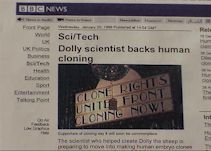 The article as it originally appeared on the BBC Web site
The article as it originally appeared on the BBC Web site